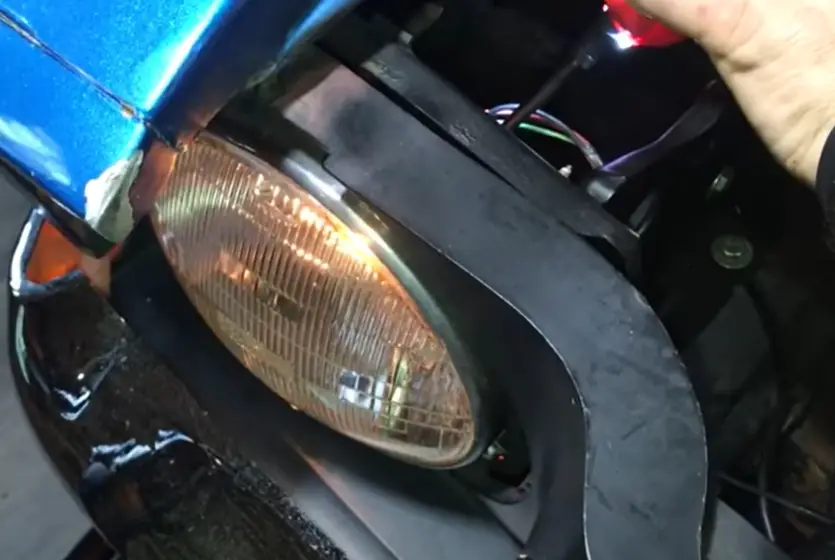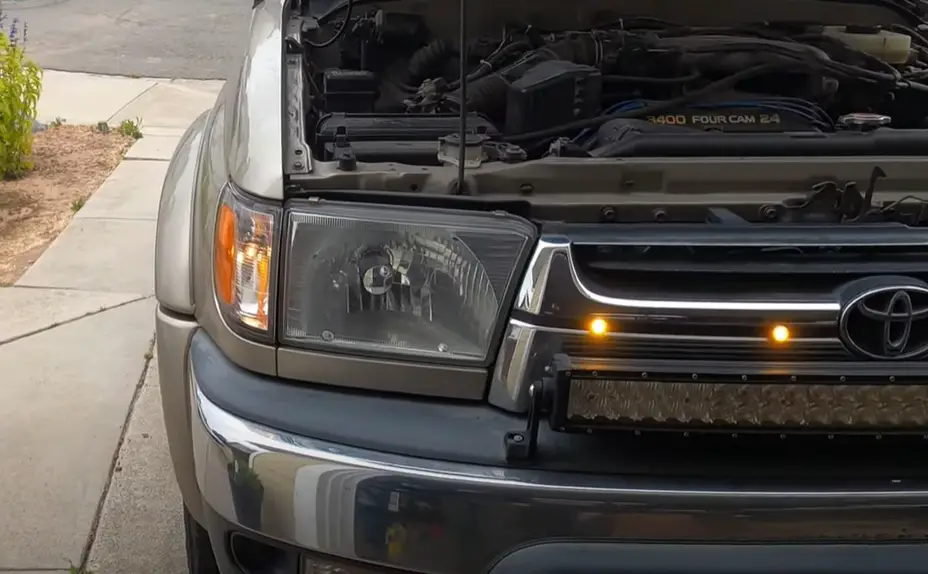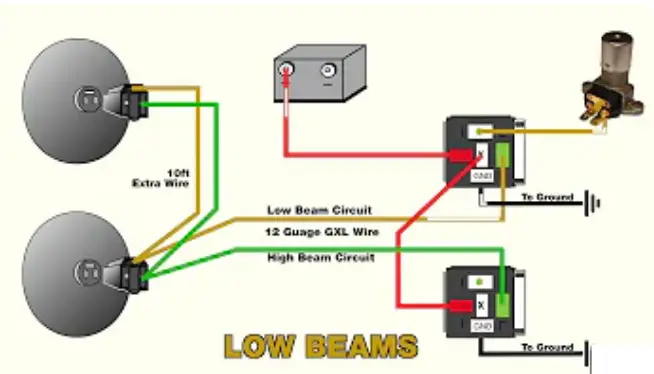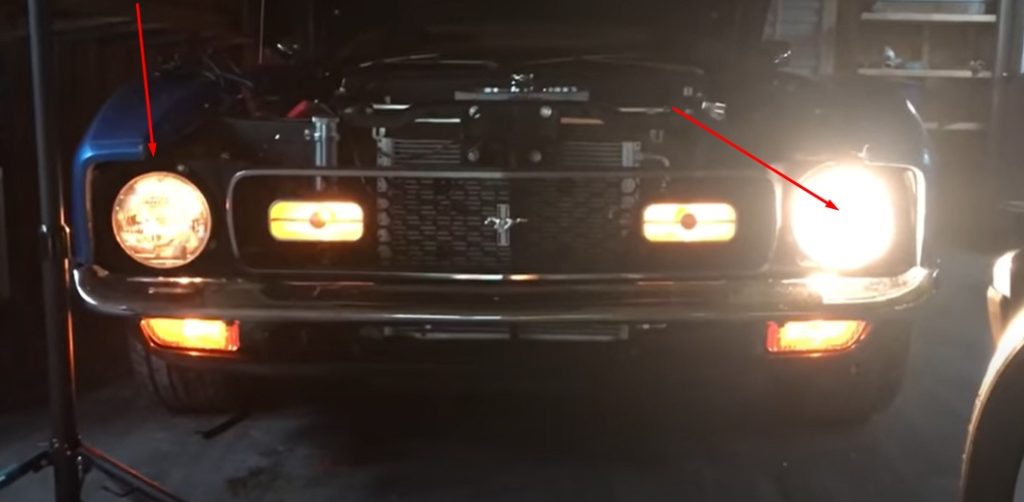Your headlights dim when you accelerate because of a drop in the electrical system’s voltage. Power demands increase as the engine works harder, leading to this issue.
Dimming headlights can be a signal that your vehicle’s electrical system is strained. This symptom often arises when there’s an acceleration-induced voltage drop, which happens if the alternator cannot supply enough power to meet the demands of the car’s electrical components.
A healthy electrical system maintains consistent headlight brightness, but when the alternator struggles or the battery’s health is compromised, the additional power required during acceleration diverts resources away from non-essential systems like the lights.

Regular maintenance checks can help prevent such issues, ensuring you’re not left in the dark while driving. Drivers should pay attention to these signs and seek a professional mechanic’s advice to keep their vehicle’s electrical system in prime condition. Let’s Define “Why Do My Headlights Dim When I Accelerate?”
Introduction To Headlight Dimming
Imagine driving at night and suddenly, your headlights dim as you press the gas pedal. This sudden change can be perplexing and alarming. Awareness why this occurs requires a grasp of your car’s electrical system. This post sheds light on the root causes of headlight dimming during acceleration. Vital components in your vehicle interact, resulting in this phenomenon.
Awareness of The Basics Of Automotive Electrical Systems
Your car’s electrical system is a complex network. It powers everything from headlights to your radio. The heart of this system is the battery and alternator. A key player here is the alternator, which charges the battery and powers electrical systems while the engine runs. Voltage fluctuations may occur during changes in engine speed, affecting headlight brightness.
- Battery: Stores the electrical power.
- Alternator: Generates power when the engine runs.
- Wiring: Carries electricity to various components.
The Phenomenon Of Headlight Dimming: What Drivers Experience
As you accelerate, your vehicle demands more power. The alternator works harder to keep up. If the electrical system can’t provide stable power, headlights may dim. This is often a sign of a weakening battery or a failing alternator. Regular maintenance can prevent these issues and keep your drive smooth and safe.
Common signs include:
| Sign | Description |
|---|---|
| Dimming Headlights | Headlights lose brightness during acceleration. |
| Weak Battery | Struggles to hold a charge affecting electronics. |
| Failing Alternator | Cannot adequately power the vehicle’s electrical systems. |
Electrical Load And Vehicle Dynamics

Awareness why your car’s headlights dim when accelerating involves looking at the electrical system. Every car relies on a balance between power drawn and power supplied. As you step on the gas, your vehicle’s dynamics change. This affects how much electrical load your system can handle.
How Acceleration Affects Electrical Load
When you accelerate, the engine needs more power and fuel. This increases the demand for the electrical system. Think of your car like a bucket with a hole. If you fill the bucket faster than it leaks, it’s fine. But if you start using water faster, you might not fill it as quickly. That’s what happens with the electrical load during acceleration.
- Engine demands more: Your engine works harder, demanding more electricity.
- Headlights compete: Headlights become rivals for the current.
- Dimming occurs: If the supply falls short, you’ll notice headlights dimming.
The Role Of The Alternator In Powering Headlights
The alternator is like the heart of your car’s electrical system. It pumps electricity to power everything, from your headlights to the radio. At idle, the alternator might not always run at full capacity. But as you accelerate, it should kick into high gear.
| Car State | Alternator Output |
|---|---|
| Idling | Low to Moderate |
| Accelerating | Increases |
If the alternator doesn’t increase output when accelerating, your headlights may dim. This could be a sign it’s time to check your vehicle’s electrical system.
- Check the alternator: Ensure it’s providing enough power.
- Inspect belts: Make sure they’re tight and in good shape.
- Look at battery health: A weak battery can’t hold charge well.
Common Causes Of Headlight Dimming

Headlight dimming during acceleration is a common issue that drivers face. It often points to problems within the vehicle’s electrical system. Recognizing the reasons behind this can help maintain your car’s performance and safety.
Failing Alternator Symptoms And Impact On Headlights
The alternator charges your battery and powers the electrical system while the engine runs. A failing alternator might not provide enough power, causing headlights to dim when accelerating. Key symptoms include:
- Dashboard warning light – an illuminated battery or ALT light.
- Weak electrical components – slow-powered windows or radio issues.
- Strange noises – unusual sounds from alternator bearing failure.
- Electrical burning smell – from the alternator overheating.
The consequence for headlights is a noticeable dip in brightness as the demand for electrical power increases with acceleration.
Battery Health And Its Effects On Electrical System Performance
A healthy battery is key for a reliable electrical system. A weak or dying battery struggles to maintain voltage, affecting headlight brightness. Signs that your battery health might be declining include:
- Difficulty starting – the engine takes longer to turn over on ignition.
- Corrosion – white, powdery substance around the battery terminals.
- Swollen battery case – a bloated appearance indicating a failing battery.
- Age – batteries over three years old may start to falter.
Dimming lights under acceleration could be your first hint that the battery needs a check-up or replacement.
Wiring And Connection Issues

Have you noticed your car’s headlights dimming when you hit the gas pedal? This surprising issue often points to wiring and connection faults in your vehicle’s electrical system. Proper electricity flow is vital for steady headlight performance. Let’s explore some common wiring problems that could be dimming your lights during acceleration.
Grounding Issues Contributing To Dimming Lights
Grounding problems in your car can lead to inconsistent headlight brightness. Every electrical circuit must have solid ground. Without this, you may experience electrical quirks, like dimming headlights during acceleration. A bad ground limits the current flow. As a result, headlights lack the power they need.
Signs of grounding issues:
- Flickering or dimming lights
- Electrical components acting up
- Unexpected battery drain
The Impact Of Corrosion And Loose Connections
Corrosion can wreak havoc on car electrical systems. Corroded terminals restrict current flow. This means less power for your headlights. Loose connections also lead to similar troubles. Vibration from your car can jostle wires. This sometimes causes the lights to dim, especially during acceleration. Keeping connections clean and tight is crucial.
| Issue | Impact | Solution |
|---|---|---|
| Corroded Terminals | Limited current, dimming lights | Clean and protect terminals |
| Loose Connections | Intermittent brightness | Inspect and secure connections |
Potential Component Failures
When your headlights dim as you accelerate, it’s a warning. Your car’s electrical system might be failing. It’s critical to identify the issue early. This helps prevent costly repairs later. A weak battery or faulty alternator could be at fault. But, there are other components to check too.
Diagnosing A Faulty Voltage Regulator
A voltage regulator controls the charge to the battery. When this component fails, your headlights might dim. To diagnose a faulty voltage regulator:
- Check the voltage with a multimeter while the car is running.
- If the readings fluctuate or are too high/low, your regulator may be failing.
- Listen for a whining sound from the alternator, as this can indicate regulator issues.
The Effects Of A Deteriorating Drive Belt On Electrical Components
Drive belts to power your alternator and other parts. A worn belt can affect your car’s electrical system. Here’s how:
| Signs of Wear | Electrical Impact |
|---|---|
| Cracks on the belt | Less efficiency in power delivery |
| Glazing or smoothness | Slippage, leading to poor alternator output |
| Peeling or fraying | Intermittent power disruption |
Regular inspection can save you from unexpected failures. Have a professional check the belt as part of routine maintenance.
Preventative Measures And Maintenance Tips
Headlight dimming during acceleration can be worrisome. Yet, you can avoid such issues with proper care. This section dives into preventive strategies. It outlines maintenance tips to keep your headlights shining bright, even as you race down the road.
Routine Checks To Prevent Headlight Dimming Issues
Maintain your car’s lighting with these steps:
- Inspect the battery – Ensuring it is secure and terminals are clean.
- Check the alternator output – Using a multimeter measure if it’s in range.
- Scan the belt condition – Replace it if you spot cracks or wear.
- Review headlight wiring – Look for frays or loose connections.
You can often tackle these checks at home, or ask a mechanic for help.
Upgrading Headlights And Electrical Components For Optimal Performance
Upgrade your car for brighter roads ahead:
- Consider LED or HID kits for a brighter beam.
- Upgrade the alternator if its output doesn’t meet your car’s demands.
- Install a larger battery for a stronger electrical system.
- Use dedicated grounding wires for improved circuit stability.
| Upgrade Type | Benefits |
|---|---|
| LED/HID Bulbs | More lumens, longer life |
| High-Output Alternator | Better electrical supply |
| Quality Battery | Consistent power output |
To sum up, preemptive upkeep and smart enhancements guarantee better visibility. They also promote your vehicle’s electrical health.
Frequently Asked Questions For Why Do My Headlights Dim When I Accelerate
Why Do My Headlights Go Dim When Accelerating?
Your headlights may dim when accelerating due to a weak battery, a failing alternator, or poor electrical connections. Check these components to ensure a consistent power supply.
Why Do My Lights Dim When I Hit The Gas?
Lights may dim when you hit the gas due to increased electrical demand from the engine. This could indicate a failing alternator or weak battery. It’s advisable to have your vehicle’s electrical system checked.
Why Do My Headlights Go Out When I Accelerate?
Headlights dimming during acceleration can indicate a failing alternator or poor electrical connections. Seek an auto electrician’s help.
Will A Weak Alternator Cause Dim Headlight?
Yes, a malfunctioning alternator can lead to dim headlights due to insufficient power supply.
Conclusion
Dimming headlights can be a sign of underlying vehicle problems. Prioritize safety and performance with a professional check-up. Consistent issues require attention, as they affect visibility and driving safety. Remember, maintaining a car’s electrical system is key for reliable, bright illumination on the road.

